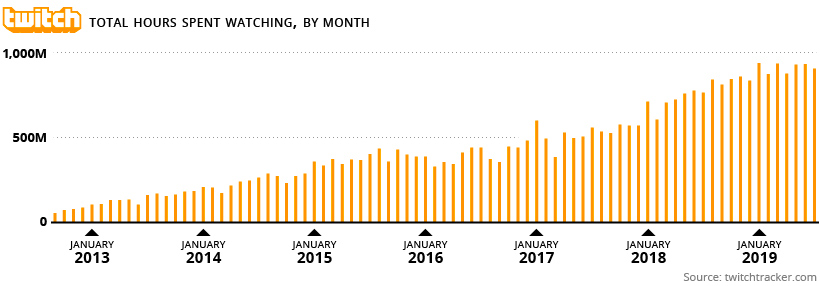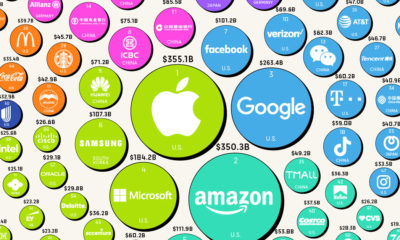To claim even the 100th spot in this ranking, your website would need around 350 million visits in a single month. Using data from SimilarWeb, we’ve visually mapped out the top 100 biggest websites on the internet. Examining the ranking reveals a lot about how people around the world search for information, which services they use, and how they spend time online. Note: This is a ranking of biggest websites, specifically. Brands that extend across platforms or serve the majority of their users through an app will not necessarily rank well on this list. As a result, you’ll notice the absence of companies like WeChat and Snapchat.
The Top 100 Websites
The 100 biggest websites generated a staggering 206 billion visits in June 2019. Google, YouTube, and Facebook took the top spots, followed by Baidu and Wikipedia. Below is the full ranking:
Search Reigns Supreme
Search engines provide the connective tissue that binds the internet together, and they accounted for the majority of website traffic in the top 100 ranking. Google is the undisputed top website in nearly every country in the world. In fact, Alphabet’s 11 domains in the top 100 ranking – including YouTube and a number of international versions of Google – racked up an impressive 90 billion visits in a single month. Exceptions to Google’s dominance can be found in China (Baidu) and Russia (Yandex), where homegrown search engines have managed to capture the domestic market. One scrappy competitor, DuckDuckGo, is slowly gaining prominence as an alternative to Google. The search engine’s focus on user privacy appears to be resonating with internet users as the site’s traffic has surpassed 500 million visits per month.
Full Stream Ahead
Video streaming and sharing is another major driver of global internet traffic. Thanks to high-powered phones and bigger data plans, video is now a prominent portion of internet content consumption. This can take a few forms, from binge watching TV shows on Netflix to short-form video uploads on platforms like Douyin and Instagram.
Of course, this category also includes adult content, which is well represented in this ranking. XNXX, XVideos, and PornHub all made the top 20, and the three websites combined for over nine billion visits in the most recent month of data available.
Old Dogs, New Tricks
Classic web portals such as MSN and Yahoo are still putting up impressive traffic numbers, but major players are increasingly staying relevant by acquiring rising internet stars. Google isn’t sitting still either. The company recently championed the open-source AMP Project to help improve the performance of mobile pages, which are increasingly bogged down by adware, unoptimized images, and JavaScript. In a short amount of time, the AMP Project has taken off to become one of the biggest websites in the world. The project is not without controversy though. Critics point out that cached AMP pages – which are hosted by Google – essentially cut out content creators, and that non-compliant pages may lose their ranking on mobile search results. As the project moves towards becoming a foundation, it remains to be seen how AMP will evolve and how much involvement Google will have in the future.
The Geography of the Top 100 Websites
Below is a breakdown of the Top 100 by country.
China is a strong runner-up, with 15 websites in the Top 100. While most of these Chinese companies are focused on the sizable domestic market, some are also making global inroads through investment. Tencent has partially backed the fast-growing chat platform, Discord, and it also has double-digit stakes in Snapchat and Spotify. With the exception of Baidu, all of the biggest websites in the world have swelled in size by serving a global audience. As the tech market continues to mature in China, it remains to be seen whether Chinese companies can successfully move beyond the firewall to become the next Facebook or Google. Correction: Bilibili, a website run by a Chinese company, was incorrectly identified as a Japanese company. on But fast forward to the end of last week, and SVB was shuttered by regulators after a panic-induced bank run. So, how exactly did this happen? We dig in below.
Road to a Bank Run
SVB and its customers generally thrived during the low interest rate era, but as rates rose, SVB found itself more exposed to risk than a typical bank. Even so, at the end of 2022, the bank’s balance sheet showed no cause for alarm.
As well, the bank was viewed positively in a number of places. Most Wall Street analyst ratings were overwhelmingly positive on the bank’s stock, and Forbes had just added the bank to its Financial All-Stars list. Outward signs of trouble emerged on Wednesday, March 8th, when SVB surprised investors with news that the bank needed to raise more than $2 billion to shore up its balance sheet. The reaction from prominent venture capitalists was not positive, with Coatue Management, Union Square Ventures, and Peter Thiel’s Founders Fund moving to limit exposure to the 40-year-old bank. The influence of these firms is believed to have added fuel to the fire, and a bank run ensued. Also influencing decision making was the fact that SVB had the highest percentage of uninsured domestic deposits of all big banks. These totaled nearly $152 billion, or about 97% of all deposits. By the end of the day, customers had tried to withdraw $42 billion in deposits.
What Triggered the SVB Collapse?
While the collapse of SVB took place over the course of 44 hours, its roots trace back to the early pandemic years. In 2021, U.S. venture capital-backed companies raised a record $330 billion—double the amount seen in 2020. At the time, interest rates were at rock-bottom levels to help buoy the economy. Matt Levine sums up the situation well: “When interest rates are low everywhere, a dollar in 20 years is about as good as a dollar today, so a startup whose business model is “we will lose money for a decade building artificial intelligence, and then rake in lots of money in the far future” sounds pretty good. When interest rates are higher, a dollar today is better than a dollar tomorrow, so investors want cash flows. When interest rates were low for a long time, and suddenly become high, all the money that was rushing to your customers is suddenly cut off.” Source: Pitchbook Why is this important? During this time, SVB received billions of dollars from these venture-backed clients. In one year alone, their deposits increased 100%. They took these funds and invested them in longer-term bonds. As a result, this created a dangerous trap as the company expected rates would remain low. During this time, SVB invested in bonds at the top of the market. As interest rates rose higher and bond prices declined, SVB started taking major losses on their long-term bond holdings.
Losses Fueling a Liquidity Crunch
When SVB reported its fourth quarter results in early 2023, Moody’s Investor Service, a credit rating agency took notice. In early March, it said that SVB was at high risk for a downgrade due to its significant unrealized losses. In response, SVB looked to sell $2 billion of its investments at a loss to help boost liquidity for its struggling balance sheet. Soon, more hedge funds and venture investors realized SVB could be on thin ice. Depositors withdrew funds in droves, spurring a liquidity squeeze and prompting California regulators and the FDIC to step in and shut down the bank.
What Happens Now?
While much of SVB’s activity was focused on the tech sector, the bank’s shocking collapse has rattled a financial sector that is already on edge.
The four biggest U.S. banks lost a combined $52 billion the day before the SVB collapse. On Friday, other banking stocks saw double-digit drops, including Signature Bank (-23%), First Republic (-15%), and Silvergate Capital (-11%).
Source: Morningstar Direct. *Represents March 9 data, trading halted on March 10.
When the dust settles, it’s hard to predict the ripple effects that will emerge from this dramatic event. For investors, the Secretary of the Treasury Janet Yellen announced confidence in the banking system remaining resilient, noting that regulators have the proper tools in response to the issue.
But others have seen trouble brewing as far back as 2020 (or earlier) when commercial banking assets were skyrocketing and banks were buying bonds when rates were low.














